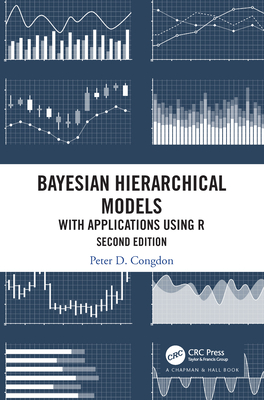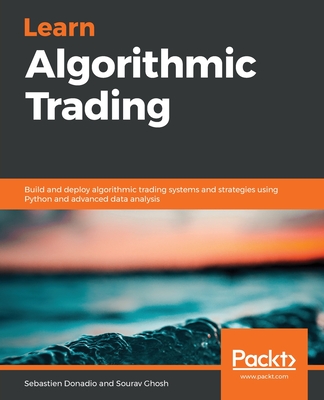Doing Bayesian Data Analysis: A Tutorial with R, JAGS, and Stan, 2/e (Hardcover)
暫譯: 貝葉斯數據分析實務:使用 R、JAGS 和 Stan 的教程,第二版 (精裝本)
John Kruschke
- 出版商: Academic Press
- 出版日期: 2015-07-08
- 售價: $3,600
- 貴賓價: 9.5 折 $3,420
- 語言: 英文
- 頁數: 776
- 裝訂: Hardcover
- ISBN: 0124058884
- ISBN-13: 9780124058880
-
相關分類:
Data Science、機率統計學 Probability-and-statistics
-
相關翻譯:
貝葉斯數據分析(第2版) (簡中版)
買這商品的人也買了...
-
 大話設計模式
大話設計模式$620$527 -
 Bayesian Networks: An Introduction (Hardcover)
Bayesian Networks: An Introduction (Hardcover)$4,260$4,047 -
 大話資料結構
大話資料結構$590$502 -
 Network Information Theory (Hardcover)
Network Information Theory (Hardcover)$1,460$1,431 -
 Bayesian Reasoning and Machine Learning (DHL)
Bayesian Reasoning and Machine Learning (DHL)$3,500$3,325 -
 $1,490Contemporary Artificial Intelligence (Hardcover)
$1,490Contemporary Artificial Intelligence (Hardcover) -
 Bayesian Ideas and Data Analysis: An Introduction for Scientists and Statisticians (Hardcover)
Bayesian Ideas and Data Analysis: An Introduction for Scientists and Statisticians (Hardcover)$3,500$3,325 -
 精通 Python|運用簡單的套件進行現代運算 (Introducing Python: Modern Computing in Simple Packages)
精通 Python|運用簡單的套件進行現代運算 (Introducing Python: Modern Computing in Simple Packages)$780$616 -
 Bayesian Methods for Hackers: Probabilistic Programming and Bayesian Inference (Paperback)
Bayesian Methods for Hackers: Probabilistic Programming and Bayesian Inference (Paperback)$1,700$1,615 -
 $1,786Programming Robots with ROS: A Practical Introduction to the Robot Operating Syste (Paperback)
$1,786Programming Robots with ROS: A Practical Introduction to the Robot Operating Syste (Paperback) -
 Artificial Intelligence for Humans, Volume 3: Deep Learning and Neural Networks
Artificial Intelligence for Humans, Volume 3: Deep Learning and Neural Networks$1,050$998 -
 $1,872Deep Learning: A Practitioner's Approach (Paperback)
$1,872Deep Learning: A Practitioner's Approach (Paperback) -
 $1,750Statistical Rethinking: A Bayesian Course with Examples in R and Stan (Hardcover)
$1,750Statistical Rethinking: A Bayesian Course with Examples in R and Stan (Hardcover) -
 Information Theory Tools for Visualization (Hardcove)
Information Theory Tools for Visualization (Hardcove)$2,600$2,470 -
 Node 學習手冊, 2/e (Learning Node: Moving to the Server-Side, 2/e)
Node 學習手冊, 2/e (Learning Node: Moving to the Server-Side, 2/e)$520$411 -
.jpg) Python + Spark 2.0 + Hadoop 機器學習與大數據分析實戰
Python + Spark 2.0 + Hadoop 機器學習與大數據分析實戰$680$530 -
 網站擷取|使用 Python (Web Scraping with Python: Collecting Data from the Modern Web)
網站擷取|使用 Python (Web Scraping with Python: Collecting Data from the Modern Web)$580$458 -
 UX 從新手開始|使用者體驗的 100堂必修課 (UX for Beginners: A Crash Course in 100 Short Lessons)
UX 從新手開始|使用者體驗的 100堂必修課 (UX for Beginners: A Crash Course in 100 Short Lessons)$480$379 -
 JavaScript 學習手冊, 3/e (Learning JavaScript: Add Sparkle and Life to Your Web Pages, 3/e)
JavaScript 學習手冊, 3/e (Learning JavaScript: Add Sparkle and Life to Your Web Pages, 3/e)$580$458 -
 你所不知道的 JS|非同步處理與效能 (You Don't Know JS: Async & Performance)
你所不知道的 JS|非同步處理與效能 (You Don't Know JS: Async & Performance)$520$411 -
 今天不學機器學習,明天就被機器取代:從 Python 入手+演算法
今天不學機器學習,明天就被機器取代:從 Python 入手+演算法$590$502 -
 Git 團隊使用手冊 (Git for Teams: A User-Centered Approach to Creating Efficient Workflows in Git)
Git 團隊使用手冊 (Git for Teams: A User-Centered Approach to Creating Efficient Workflows in Git)$580$458 -
 Python 自動化的樂趣|搞定重複瑣碎 & 單調無聊的工作 (中文版) (Automate the Boring Stuff with Python: Practical Programming for Total Beginners)
Python 自動化的樂趣|搞定重複瑣碎 & 單調無聊的工作 (中文版) (Automate the Boring Stuff with Python: Practical Programming for Total Beginners)$500$395 -
 遊戲大師天堂路:只有 Unity Shader 才能超越 Unity
遊戲大師天堂路:只有 Unity Shader 才能超越 Unity$590$502 -
 Robotics, Vision and Control: Fundamental Algorithms In MATLAB, 2/e (Paperback)
Robotics, Vision and Control: Fundamental Algorithms In MATLAB, 2/e (Paperback)$3,210$3,050
商品描述
There is an explosion of interest in Bayesian statistics, primarily because recently created computational methods have finally made Bayesian analysis obtainable to a wide audience. Doing Bayesian Data Analysis: A Tutorial with R, JAGS, and Stan provides an accessible approach to Bayesian data analysis, as material is explained clearly with concrete examples. The book begins with the basics, including essential concepts of probability and random sampling, and gradually progresses to advanced hierarchical modeling methods for realistic data. Included are step-by-step instructions on how to conduct Bayesian data analyses in the popular and free software R and WinBugs. This book is intended for first-year graduate students or advanced undergraduates. It provides a bridge between undergraduate training and modern Bayesian methods for data analysis, which is becoming the accepted research standard. Knowledge of algebra and basic calculus is a prerequisite.
New to this Edition (partial list):
- There are all new programs in JAGS and Stan. The new programs are designed to be much easier to use than the scripts in the first edition. In particular, there are now compact high-level scripts that make it easy to run the programs on your own data sets. This new programming was a major undertaking by itself.
- The introductory Chapter 2, regarding the basic ideas of how Bayesian inference re-allocates credibility across possibilities, is completely rewritten and greatly expanded.
- There are completely new chapters on the programming languages R (Ch. 3), JAGS (Ch. 8), and Stan (Ch. 14). The lengthy new chapter on R includes explanations of data files and structures such as lists and data frames, along with several utility functions. (It also has a new poem that I am particularly pleased with.) The new chapter on JAGS includes explanation of the RunJAGS package which executes JAGS on parallel computer cores. The new chapter on Stan provides a novel explanation of the concepts of Hamiltonian Monte Carlo. The chapter on Stan also explains conceptual differences in program flow between it and JAGS.
- Chapter 5 on Bayes’ rule is greatly revised, with a new emphasis on how Bayes’ rule re-allocates credibility across parameter values from prior to posterior. The material on model comparison has been removed from all the early chapters and integrated into a compact presentation in Chapter 10.
- What were two separate chapters on the Metropolis algorithm and Gibbs sampling have been consolidated into a single chapter on MCMC methods (as Chapter 7). There is extensive new material on MCMC convergence diagnostics in Chapters 7 and 8. There are explanations of autocorrelation and effective sample size. There is also exploration of the stability of the estimates of the HDI limits. New computer programs display the diagnostics, as well.
- Chapter 9 on hierarchical models includes extensive new and unique material on the crucial concept of shrinkage, along with new examples.
- All the material on model comparison, which was spread across various chapters in the first edition, in now consolidated into a single focused chapter (Ch. 10) that emphasizes its conceptualization as a case of hierarchical modeling.
- Chapter 11 on null hypothesis significance testing is extensively revised. It has new material for introducing the concept of sampling distribution. It has new illustrations of sampling distributions for various stopping rules, and for multiple tests.
- Chapter 12, regarding Bayesian approaches to null value assessment, has new material about the region of practical equivalence (ROPE), new examples of accepting the null value by Bayes factors, and new explanation of the Bayes factor in terms of the Savage-Dickey method.
- Chapter 13, regarding statistical power and sample size, has an extensive new section on sequential testing, and making the research goal be precision of estimation instead of rejecting or accepting a particular value.
- Chapter 15, which introduces the generalized linear model, is fully revised, with more complete tables showing combinations of predicted and predictor variable types.
- Chapter 16, regarding estimation of means, now includes extensive discussion of comparing two groups, along with explicit estimates of effect size.
- Chapter 17, regarding regression on a single metric predictor, now includes extensive examples of robust regression in JAGS and Stan. New examples of hierarchical regression, including quadratic trend, graphically illustrate shrinkage in estimates of individual slopes and curvatures. The use of weighted data is also illustrated.
- Chapter 18, on multiple linear regression, includes a new section on Bayesian variable selection, in which various candidate predictors are probabilistically included in the regression model.
- Chapter 19, on one-factor ANOVA-like analysis, has all new examples, including a completely worked out example analogous to analysis of covariance (ANCOVA), and a new example involving heterogeneous variances.
- Chapter 20, on multi-factor ANOVA-like analysis, has all new examples, including a completely worked out example of a split-plot design that involves a combination of a within-subjects factor and a between-subjects factor.
- Chapter 21, on logistic regression, is expanded to include examples of robust logistic regression, and examples with nominal predictors.
- There is a completely new chapter (Ch. 22) on multinomial logistic regression. This chapter fills in a case of the generalized linear model (namely, a nominal predicted variable) that was missing from the first edition.
- Chapter 23, regarding ordinal data, is greatly expanded. New examples illustrate single-group and two-group analyses, and demonstrate how interpretations differ from treating ordinal data as if they were metric.
- There is a new section (25.4) that explains how to model censored data in JAGS.
- Many exercises are new or revised.
- Accessible, including the basics of essential concepts of probability and random sampling
- Examples with R programming language and JAGS software
- Comprehensive coverage of all scenarios addressed by non-Bayesian textbooks: t-tests, analysis of variance (ANOVA) and comparisons in ANOVA, multiple regression, and chi-square (contingency table analysis)
- Coverage of experiment planning
- R and JAGS computer programming code on website
- Exercises have explicit purposes and guidelines for accomplishment
-
Provides step-by-step instructions on how to conduct Bayesian data analyses in the popular and free software R and WinBugs
商品描述(中文翻譯)
有關貝葉斯統計的興趣正在迅速增長,主要是因為最近創建的計算方法終於使貝葉斯分析對廣大受眾變得可及。《Doing Bayesian Data Analysis: A Tutorial with R, JAGS, and Stan》提供了一種可接近的貝葉斯數據分析方法,內容以清晰的方式解釋,並附有具體的例子。本書從基礎開始,包括概率和隨機抽樣的基本概念,然後逐步進展到針對現實數據的高級層次模型方法。書中包含了如何在流行且免費的軟體 R 和 WinBugs 中進行貝葉斯數據分析的逐步指導。本書適合一年級研究生或高年級本科生,提供了本科訓練與現代貝葉斯數據分析方法之間的橋樑,這些方法正成為公認的研究標準。具備代數和基本微積分的知識是先決條件。
本版新內容(部分清單):
- JAGS 和 Stan 中有全新的程式。這些新程式的設計比第一版中的腳本更易於使用。特別是,現在有緊湊的高級腳本,使得在自己的數據集上運行程式變得簡單。這項新程式設計本身就是一項重大工作。
- 介紹性第二章,關於貝葉斯推斷如何在可能性之間重新分配可信度的基本概念,已完全重寫並大幅擴展。
- 有全新的章節介紹程式語言 R(第 3 章)、JAGS(第 8 章)和 Stan(第 14 章)。關於 R 的新章節詳細說明了數據文件和結構,如列表和數據框,以及幾個實用函數。(這裡還有一首我特別滿意的新詩。)關於 JAGS 的新章節包括對 RunJAGS 套件的解釋,該套件在平行計算核心上執行 JAGS。關於 Stan 的新章節提供了哈密頓蒙特卡羅概念的新解釋。該章節還解釋了 Stan 與 JAGS 之間的程式流程概念差異。
- 第 5 章關於貝葉斯定理已大幅修訂,新的重點在於貝葉斯定理如何在先驗和後驗之間重新分配參數值的可信度。模型比較的內容已從所有早期章節中移除,並整合到第 10 章的緊湊呈現中。
- 原本兩個獨立的章節關於 Metropolis 演算法和 Gibbs 取樣已合併為一個關於 MCMC 方法的章節(第 7 章)。第 7 章和第 8 章中有大量新的 MCMC 收斂診斷材料。包括自相關和有效樣本大小的解釋。還探討了 HDI 限制估計的穩定性。新的電腦程式也顯示了診斷結果。
- 第 9 章關於層級模型包括大量新的獨特材料,重點在於收縮的關鍵概念,並附有新的例子。
- 所有關於模型比較的材料,原本分散在第一版的各個章節中,現在整合為一個專注的章節(第 10 章),強調其作為層級建模的一種概念化。
- 第 11 章關於虛無假設顯著性檢驗已大幅修訂。新增了介紹抽樣分佈概念的材料。新增了針對各種停止規則的抽樣分佈插圖,以及針對多重檢驗的插圖。
- 第 12 章關於虛無值評估的貝葉斯方法,新增了有關實用等價區域(ROPE)的材料,新的例子展示了如何通過貝葉斯因子接受虛無值,並對貝葉斯因子進行了基於 Savage-Dickey 方法的新解釋。
- 第 13 章關於統計檢定力和樣本大小,新增了一個關於序列檢測的廣泛新部分,並將研究目標設定為估計的精確度,而不是拒絕或接受特定值。
- 第 15 章介紹廣義線性模型,已全面修訂,提供更完整的表格顯示預測變數和預測變數類型的組合。
- 第 16 章關於均值估計,現在包括對比兩組的廣泛討論,以及對效應大小的明確估計。
- 第 17 章關於單一度量預測變數的回歸,現在包括 JAGS 和 Stan 中穩健回歸的廣泛例子。新的層級回歸例子,包括二次趨勢,圖示化了個別斜率和曲率估計的收縮。加權數據的使用也有示範。
- 第 18 章關於多元線性回歸,新增了一個關於貝葉斯變數選擇的部分,其中各種候選預測變數以概率方式納入回歸模型。
- 第 19 章關於單因子 ANOVA 類分析,包含全新的例子,包括一個完全解釋的例子,類似於協方差分析(ANCOVA),以及一個涉及異質變異數的新例子。
- 第 20 章關於多因子 ANOVA 類分析,包含全新的例子,包括一個完全解釋的分割設計例子,涉及一個內部因素和一個外部因素的組合。
- 第 21 章關於邏輯回歸,擴展至包括穩健邏輯回歸的例子,以及具有名義預測變數的例子。
- 有一個全新的章節(第 22 章)關於多項邏輯回歸。這一章填補了第一版中缺失的廣義線性模型的一個案例(即名義預測變數)。
- 第 23 章關於序數數據,已大幅擴展。新的例子展示了單組和雙組分析,並演示了如何解釋與將序數數據視為度量數據的不同。
- 有一個新部分(25.4)解釋如何在 JAGS 中建模截尾數據。
- 許多練習是新的或已修訂。
- 可接近,包括概率和隨機抽樣的基本概念
- 包含 R 程式語言和 JAGS 軟體的例子
- 全面涵蓋非貝葉斯教科書所涉及的所有情境:t 檢驗、變異數分析(ANOVA)及 ANOVA 中的比較、多元回歸和卡方(列聯表分析)
- 涵蓋實驗計劃
- 網站上提供 R 和 JAGS 的電腦程式碼
- 練習有明確的目的和完成指導
- 提供如何在流行且免費的軟體 R 和 WinBugs 中進行貝葉斯數據分析的逐步指導






























